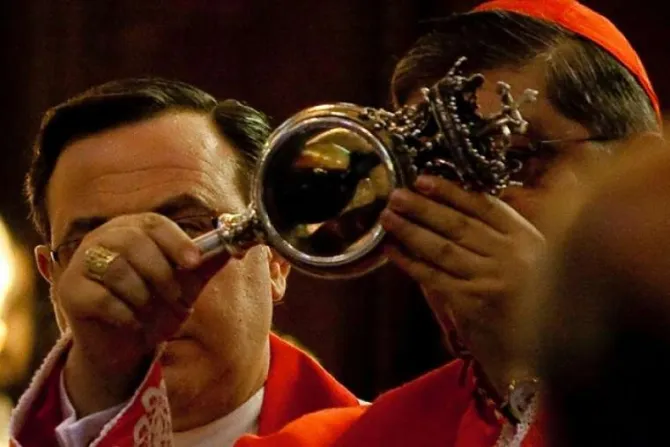Rome Newsroom, Dec 16, 2020 / 12:00 pm
In Naples, the blood of St. Januarius remained solid Wednesday, after having liquefied both in May and September this year.
"When we took the reliquary from the safe, the blood was absolutely solid and remains absolutely solid," said Fr. Vincenzo de Gregorio, abbot of the Chapel of St. Januarius in Naples Cathedral.
De Gregorio displayed the reliquary and the solidified blood inside to those gathered after morning Mass Dec. 16 in the Cathedral of the Assumption of Mary.
The abbot said that the miracle sometimes occurred later in the day. In a video he could be seen saying "a few years ago at five in the afternoon, the home stretch, it liquefied. So we don't know what's going to happen."
"The actual state, as you can see well, is absolutely solid. It does not give any sign, not even a little drop, as sometimes falls," he added. "It's alright, we will await the sign with faith."
By the end of the day's evening Mass, however, the blood was still solid.
Dec. 16 marks the anniversary of Naples' preservation from the 1631 eruption of Mount Vesuvius. It is just one of three days per year the miracle of the liquefaction of St. Januarius' blood often occurs.
The reputed miracle has not been officially recognized by the Church, but is known and accepted locally and is considered to be a good sign for the city of Naples and its region of Campania.
In contrast, the failure of the blood to liquefy is believed to signal war, famine, disease, or other disasters.
"Mi raccomando state a distanza tutti quanti...mi raccomando. Abbiate pazienza."💕
- Sunny 🇪🇺 se_vi_spinate_per_hobby_non_seguitemi (@Sunny77) December 16, 2020
"E quindi...va bene...Aspettiamo 👀con fiducia il segno. Vi auguro buona giornata..."
Che bella voce, e che gentilezza Mons. De Gregorio!#sangennaro https://t.co/JVuV7FYMTo
But according to an Italian journalist, it is not very common for the miracle to take place on Dec. 16. The blood has liquefied most often on St. Januarius' feast day of Sept. 19, and on the Saturday before the first Sunday of May.
Vatican journalist Francesco Antonio Grana told CNA that the liquefaction "almost never" happens on Dec. 16 and that in the last 34 years the number of times it has happened "can be counted on one hand."
The blood also did not liquefy in December 2016.
Cardinal Crescenzio Sepe, the archbishop emeritus of Naples, said Mass in the cathedral to mark the feast day.
When the miracle still did not occur, Sepe told those gathered, "we want to make an act of true and profound devotion to our St. Januarius, we are united in his name."
(Story continues below)
"It is he who helps us to live, to bear witness to the faith, and even if the blood does not liquefy, it does not mean goodness knows what," the cardinal continued. "The important thing is that we feel truly united, participating in this very special event which is our devotion to our patron saint."
Sepe's resignation as archbishop of Naples was accepted by Pope Francis on Saturday. The 77-year-old archbishop has led the important Italian archdiocese for 14 years.
The 57-year-old Bishop Domenico Battaglia, known as a "street priest" who is close to the poor, was named as his successor.
St. Januarius, or San Gennaro in Italian, is the patron saint of Naples. He was bishop of Benevento in the third century, and his bones and blood are preserved in the Naples cathedral as relics. He is believed to have been martyred during the Christian persecution of Emperor Diocletian.
When St. Januarius' blood liquefied in September, Cardinal Sepe addressed a mostly empty cathedral, due to coronavirus restrictions.
He announced that the blood had "completely liquefied, without any clots, which has happened in past years."
The miracle also occurred in May, when Naples was under lockdown together with the rest of Italy.
Speaking after a livestreamed Mass at the cathedral May. 2, Sepe said: "I have a big announcement to make: even in this time of coronavirus, the Lord through the intercession of St. Januarius has liquefied the blood!"
This story was updated at 12:32 p.m. Mountain Time to reflect the fact that St. Januarius' blood had still failed to liquefy by the end of the day's celebrations.





